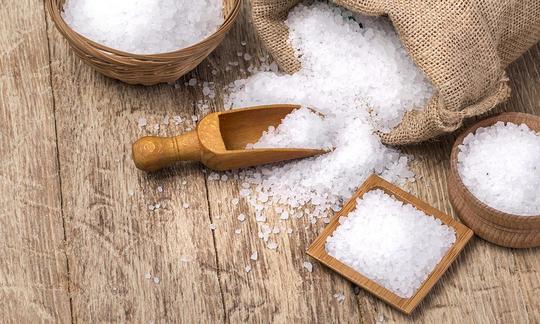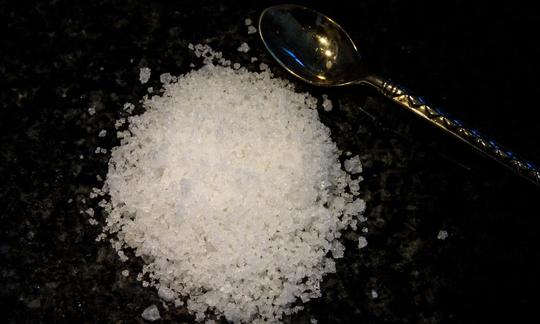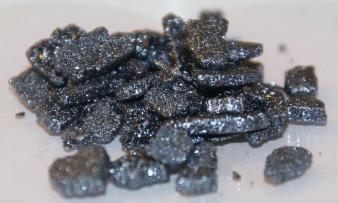Table of contents
Sea salt is a salt extracted from sea water that is used just like rock salt to season raw and cooked foods. There is no such thing as organic sea salt.
Use in the kitchen
Sea salt is the name given to salt that is obtained by evaporating sea water (or water from saltwater lakes). Like rock salt, sea salt is a table salt, a salt suitable for consumption. This article is specifically about sea salt. In the article " Salt, Table Salt " you can find out more about table salt in general.
In general, the salt crystals of sea salt are larger and coarser than those of rock salt due to the residual moisture content. However, the size is variable and according to the sea salt standards, the salt crystals can be divided into coarse (>3 mm), fine (1-3 mm) and extra fine (<1 mm). The hand-made Fleur de Sel (salt flower, flower of salt), the best known and most expensive representative of sea salt, has particularly fine, soft crystals or flakes. 1
The taste of sea salt can be described primarily as salty. The minerals and trace elements it contains can contribute to a characteristic aroma. 1 Sea salt can be used like other table salt: for preparing all kinds of dishes and for subsequent refinement. Sea salt is not only used to season savoury dishes, vegan desserts and pastries also benefit from a pinch.
Sea salt, just like rock salt, has the ability to improve the palatability of food. It not only gives dishes the desired salty taste, but also enhances the perception of other aromatic compounds and influences the activity of some enzymes responsible for flavor formation. 2
As a result, salt is a frequently used food additive in industrial food processing and one of the most popular spices in many households. 2 Many people consume too much salt. Excessive salt consumption has a negative impact on health (see chapter "Danger - Intolerances - Side Effects").
It is best to avoid eating ready meals and processed foods that contain a lot of salt. Season with other spices, herbs or other flavorings (e.g. onion, garlic, lime) and add a little salt to taste. Raw food dishes often do not need to be salted at all as they naturally taste slightly salty. When cooking, some of the salt contained in the food dissolves and passes into the water, which is usually thrown away, so you can add a little salt. The maximum recommended daily consumption amounts can be found in the chapter "Effects on health".
Apart from its use as a seasoning and additive, salt is used as a preservative for various foods (e.g. meat, fish, cheese, vegetables) as it reduces water activity and inhibits bacterial growth. 1,2
Vegan recipe for thyme-lemon sea salt
Ingredients: 100 g fine sea salt, 1 organic lemon, ¼ bunch of fresh thyme.
Preparation: Rinse the organic lemon with hot water and grate the peel. Make sure that you only grate the colored peel (flavedo) and not the white layer (albedo), as this tastes bitter. Rinse the thyme, shake it dry and pick off the leaves. Add the lemon peel and thyme leaves to the sea salt and mix. Pour the mixture onto a baking tray lined with baking paper, spread it out evenly and leave to dry overnight. Fill the vegan thyme-lemon sea salt into a screw-top jar or, if you're giving it as a gift, into small test tubes with a cork and seal it tightly. If well sealed and stored in a dry place, the salt will keep for several months.
Vegan recipes with sea salt can be found under the note: " Recipes that have the most of this ingredient ".
| Not only vegans or vegetarians should read this: Vegans often eat unhealthily. Avoidable nutritional errors. |
Purchasing - Storage
Sea salt can be bought in most supermarkets (e.g. Coop, Migros, Denner, Volg, Spar, Aldi, Lidl, Rewe, Edeka, Hofer, Billa) and organic supermarkets (e.g. Denn's Biomarkt, Alnatura). Sea salts differ from one another mainly in terms of crystal size (fine-grained or coarse-grained) and origin. Sea salt can also be natural or refined (washed, filtered, heated). You can also find sea salt with or without iodine, fluoride and/or anti-caking agents. Sea salt is sold in mills, cardboard or plastic packaging.
Is there organic sea salt? Since salt, including sea salt, is an inorganic product that does not come from agriculture (cultivation, production), it cannot meet the requirements of organic agricultural products. There is therefore no such thing as certified organic salt or organic sea salt. Nevertheless, (non-certified) organic salt can be found, since salt is included in the scope of the organic regulation, but without any special European rules. 3,4 The German Organic Food Industry Association ( BÖLW) is demanding that salt be removed from the scope of the organic regulation, since the extraction of a mineral does not fit the logic of environmentally friendly organic farming (without the use of mineral nitrogen fertilizers and chemical-synthetic pesticides) and thus only causes confusion. 4
You can find sea salt described as raw in online stores. It is not clear whether this really indicates raw food or whether it is an allusion to unprocessed quality. The general rule for raw food is that foods and products that have been heated to temperatures above 42 °C are not raw. This is important for plant-based substances because cells die above 42 °C (slightly higher for animal substances), but no matter how salt is heated, it is not important in this respect. Sodium and chlorine came to the earth when it was formed around 4.6 billion years ago. So it was there when the earth was glowing. We have included the terms "raw" and "organic" in the title so that you can find the answers to these questions.
The availability of sea salt varies depending on the size of the store, catchment area, etc. Our recorded food prices for the DA-CH countries can be found above under the ingredient image - and by clicking you can see their development at different suppliers.
Storage tips
Sea salt is best stored tightly closed in a dry place at room temperature. This way the salt will last for several years.
Ingredients - Nutritional values - Calories
We realistically show you the ingredients of this mineral per 1 g (instead of per 100 g as usual).
Does sea salt contain nutrients? Sea salt contains neither carbohydrates nor proteins nor fat and therefore has no calories. Sea salt also does not contain any vitamins. Sea salt is a mixture of salts. The largest part is table salt, i.e. sodium chloride (NaCl): 1 g of sea salt consists of almost 100% (965.2 mg/1g) sodium chloride. Of this, 380 mg/1g is sodium (Na). In addition to sodium chloride, sea salt also contains small amounts of minerals such as magnesium (0.37 mg/1g), manganese (0.002 mg/1g), calcium (0.51 mg/1g) and potassium (0.56 mg/1g) as well as trace elements such as iodine (1 µg/1g), iron (0.03 mg/1g), copper (0.0014 mg/1g), fluoride (4.8 µg/1g) and zinc. 5,6
In contrast to table salt, sea salt contains about 2% water (residual moisture).
The complete ingredients of sea salt, the coverage of the daily requirement and comparison values with other ingredients can be found in our nutrient tables. In the article Nutrients explained you will get a detailed insight into the topic.
Health Effects
Salt is the general name for sodium chloride (NaCl). Sodium chloride is an essential component of our diet and contributes to the body's homeostasis (balance of body functions). Salt regulates the body's water content (fluid balance) and is necessary for osmotic balance in human cells. Sodium is essential for the transmission of nerve impulse signals, regulates pH and absorption of nutrients, and enables the blood to transport carbon dioxide from the tissues to the lungs. All human fluids, including blood, sweat, tears, and digestive juices, contain salt. 1,2
Sea salt contains natural minerals such as magnesium, potassium and calcium. Studies have shown that these minerals have a positive effect on human health. Magnesium, for example, is involved in over 600 enzymatic reactions in the human body. Adding magnesium and potassium to salt is said to reduce the health risks associated with salt. 7 However, compared to other foods, these amounts are negligible. However, in countries where iodine is added, be aware that if you avoid salt, you will be taking in iodine (iodine), for example, from algae (such as bladderwrack).
Although salt performs important functions in the body, salt consumption is above the recommended levels almost worldwide. The World Health Organization ( WHO) recommends that adults consume no more than 5 g of salt per day (about 1 level teaspoon) and children 2 g per day. In the European region, salt consumption currently ranges between 8 g and 19 g, while the global average is just under 11 g/ day.8,9 Excessive salt consumption leads to serious health problems (see the following chapter).
Which is better: rock salt or sea salt? From a nutritional point of view, rock salt and sea salt can be considered equal. The main component of both salts is sodium chloride. Sea salt contains slightly more, but still irrelevant amounts of minerals and trace elements. These do not justify preferring sea salt - they can be better absorbed from other, healthier foods anyway. Neither sea salt nor other table salt therefore offers any significant health benefits. You can choose the type of salt according to your taste - more natural and environmentally friendly salts are preferable. Reduced, moderate consumption is necessary for all salts.
Secondary plant substances
Secondary plant substances are not relevant to the nutritional profile of sea salt. Find out more about the importance and classification of these bioactive substances in foods in the article on secondary plant substances.
Dangers - Intolerances - Side effects
The World Health Organization ( WHO) recommends limiting the intake of sodium chloride to 5 g (2 g sodium) per day, as high salt consumption is associated with an increased risk of high blood pressure, cardiovascular disease, kidney failure, stomach cancer, osteoporosis, obesity and Meniere's disease. 1,2,9 According to the WHO, an estimated 1.89 million deaths per year are linked to excessive sodium consumption. 9
The results of a 2022 sea salt study on rats suggest that high sea salt intake can lead to kidney dysfunction and problems with gut health. In addition, the researchers of this study found that the salt-related physiological changes in the rats were gender-specific. Further research is needed. 7
In many countries, 75-80% of the salt consumed daily comes from processed foods. The WHO recommends clear and consistent nutrition labelling on the front of packaging to help consumers better understand the nutritional content of the food they buy. 8
Since salt taste plays an essential role in food selection and dish palatability, research is being conducted into ways to improve salt perception and thus reduce salt consumption. A 2022 study confirmed the role of Mediterranean aromatic plants (e.g. herbs) in improving the perception of saltiness and qualified the use of flavored sea salt in food preparation instead of regular salt as a possible strategy to reduce daily salt intake. 2
Reduce your salt (sodium) intake by:
- Eat mainly fresh, unprocessed foods.
- severely limit the consumption of processed foods and convenience products.
- Choose low-sodium, low-salt products.
- Use little or no salt when cooking.
- Season food with other spices and herbs instead of salt. 9
Much of the sea salt available on the market is contaminated with microplastics. Several studies have found a wide range of harmful effects of microplastics in various organisms, which are due to microplastics penetrating cells, including those of humans. A 2023 study examined the effect of processing sea salt on microplastic residues. The researchers were able to identify fewer microplastics in crushed and washed sea salt than in unprocessed sea salt. However, microplastic particles also remained in the processed sea salt. The most noticeable microplastic contaminants were polyamide and polyurethane. 10 Before you buy, it is best to find out about salt brands that have been shown to be microplastic-free in tests or studies.
Folk medicine - natural healing
Salt water gargling is a home remedy for sore throats. Sea water is an ingredient in many nasal sprays for blocked noses and colds.
Ecological footprint - animal welfare
The ecological footprint of sea salt is primarily determined by the type of production (including energy source), transport and packaging. The heat of the sun, the most natural energy source, is used to produce sea salt. Countries without access to the sea have to import sea salt from more or less far away, which causes greenhouse gas emissions. The production of packaging such as disposable mills, plastic bags or boxes also leads to emissions.
Unfortunately, we were only able to find exact figures for one product: According to one calculation, Mexican sea salt had 0.06 kg CO 2 eq/kg. 12 That is a very small footprint. According to the Danish climate database Concito , table salt has even less at 0.44 kg CO 2 eq/kg. 14
For detailed explanations of various sustainability indicators (such as ecological footprint, CO2 footprint, water footprint), see our article: What does the ecological footprint mean?.
In connection with ecological impacts, the issue of microplastics is also important to us: Since a lot of plastic waste ends up in the sea, a lot of microplastics also end up in sea salt. No plastic could be detected in the rock salt from the mine. 13
Worldwide occurrence - Cultivation
Salt production is thought to date back to 6000 BC, when people in the northern province of Shanxi in China harvested the salt crystals formed in a lake. Major civilizations such as the Romans recognized the value of salt and built their own saltworks throughout the empire. They used salt as a commodity and also to preserve and process various foods (eg milk, pork, vegetables). Over the centuries, trade in certain products such as salted fish formed the basis of the economy of certain peoples, as in the case of the Basques. 1
Where does sea salt come from? The sea salt extraction process using successive evaporation basins probably originated with the Phoenicians, who introduced it to some Mediterranean regions of Greece, Italy and Spain. Later, in the Roman Empire, this type of production was practiced in certain places along the Atlantic coast of Spain, Portugal and France. Today, most of this traditional sea salt extraction is concentrated in a few historic saltworks. 1
The total world production of salt (rock salt and sea salt) is about 300 million tons, with China, the United States, India, followed at some distance by Germany, Canada and Australia being the six largest salt producers in the world. More than a third of the world's salt production comes from the evaporation of sea water using solar energy. 11
Salt extraction from sea water
In a solar saltworks, salt (sometimes called solar salt) is extracted from brine (an aqueous solution of salts) through solar radiation and the resulting evaporation of the water. The brine can be sea water, but also water from saltwater lakes or a saltwater mixture that people produce themselves by pumping water into an underground salt deposit to dissolve the salt.
How is sea salt extracted? The focus here is on the traditional extraction of salt from seawater. Seawater salt pans (salt gardens) consist of a series of shallow basins through which seawater flows and evaporates due to solar radiation, leaving behind brines with different salinity gradients. The structure of a traditional seawater salt pan can vary from region to region, but there are common characteristics: They are small units (usually with an area of 10 to 40 hectares) that are usually located in estuaries where clay provides ideal conditions for the impermeability of the basins. The salt pans are located in a shallow region at sea level so that spring tides can fill them with seawater. They are also located in regions where total evaporation exceeds total precipitation, i.e. warm, rain-poor places. 1
The salt marshes are divided into three different phases: reservoir, evaporation and crystallization. The reservoir receives the seawater. Most of the organic material (e.g. algae) is allowed to precipitate in it. The seawater then enters the evaporation basin, where the water content is reduced to a relative density of 20 °Bé (degrees Baumé). This area is divided into different compartments depending on their position in relation to the reservoir. Other salts with low solubility such as CaCO 3, Fe 2 O 3 and CaSO 4 also crystallize during this phase. In the crystallization area, sodium chloride is finally obtained with a relative density between 26 and 28.5 Be. Salts such as MgCl 2, MgSO 4, NaBr and KCl also precipitate in this area. 1
The careful harvesting of the salt crystals is of crucial importance. Traditionally, this task is done by hand using special wooden instruments. The salt that forms on the bottom of the crystallization tanks is very consistent and compact. During harvesting, these salt deposits are broken up using the device provided for this purpose. The salt is then usually washed with crystallizer brine, the harvested salt is piled up on wooden boards next to the crystallization tanks and left to dry in the sun. On days with special weather conditions (including a light breeze), a thin layer of salt crystals forms on the surface, which is known as fleur de sel ("flower of salt"). 1
Collecting the "flower of salt" requires special attention, as the crystals are extremely fragile and could sink before harvesting and mix with the rest of the sea salt. Once this special layer is harvested, the excess water is removed and the remaining sea salt is packed in stainless steel containers. The salt is left to dry for at least five days and then packed in food-grade boxes or bags. 1
Depending on weather conditions, sea salt production in the northern hemisphere begins in June and ends in August. Salt production depends essentially on high light intensity, high temperatures and low relative humidity. 1
Further processing, such as cleaning and artificial drying, is not permitted after the harvest of traditionally obtained sea salt, which is why it usually contains other precipitated salts in addition to sodium chloride. Food additives such as anti-caking agents, also known as flow agents (e.g. calcium ferrocyanide, potassium ferrocyanide or sodium ferrocyanide) are prohibited. The addition of ingredients from organic farming (e.g. herbs) and algae is permitted. 1
Sea salt is mainly classified according to the way it is produced. In addition to the traditional method of sea salt production, there are large-scale salt mines and industrial methods in which salt water from saline waters is pumped into basins via pipes. Salt is obtained in several steps, which may also include artificial heat during the precipitation of the salt in the salt water as well as during drying, cleaning and crushing. Industrially produced sea salt is usually refined (washed, filtered, heated). 10
Further information
Researchers proposed various forms of salt classification, including classification according to the method of extraction:
- Rock salt: comes from open-pit or underground mining of halite deposits; is extracted using conventional mining methods.
- Solar salt: from sea water and salt lakes; obtained through solar radiation and evaporation; this includes sea salt.
- Brine: obtained by dissolving underground salt deposits (solution mining); the product obtained can be used in its original form, as a solution, or used to extract the fourth class of salt (vacuum salt).
- Vacuum salt: obtained through mechanical evaporation technology (also possible with sea water or other sources of salt solutions). 1
Well-known types of sea salt include Fleur de Sel (Fior(e) di sale, Flor del mar), Sel gris, red Hawaiian salt and black lava salt.
The term table salt or cooking salt (or simply salt) includes all salts suitable for consumption. Read more about table salt (table salt) in general in the corresponding article.
Alternative names
In English, sea salt is called sea salt.
Other uses
Sea salt can be found in cosmetic products such as peelings for skin impurities, bath salts or hair sprays (sea salt spray). Salt is also an effective household remedy for red wine stains.
Bibliography - 14 Sources (Link to the evidence)
| 1. | Galvis-Sánchez AC, Lopes JA et al. Chapter 26: Sea Salt. In: De la Guardia M, Gonzáles A (Ed.). Comprehensive Analytical Chemistry. Handbook. 2013;60:719-740. |
| 2. | Rosa A, Pinna I et al. Flavoring of sea salt with Mediterranean aromatic plants affects salty taste perception. J Sci Food Agric. 2022;102(13):6005-6013. |
| 3. | Umweltberatung at: Nicht alles kann BIO sein! |
| 4. | BÖLW Bund Ökologische Lebensmittelwirtschaft. Keine EU-Regeln für Bio-Salz. |
| 5. | ÖNWT Österreichische Nährwerttabelle. Meersalz. |
| 6. | Chemie de: Meersalz. |
| 7. | Chanmuang S, Kim BM et al. Effects of sea salt intake on metabolites, steroid hormones, and gut microbiota in rats. PLoS One. 2022;17(8):e0269014. |
| 8. | WHO World Health Organization. Fünf Empfehlungen zur Reduzierung der Salzzufuhr für ein längeres und gesünderes Leben. 2022. |
| 9. | WHO World Health Organization. Sodium reduction. 2023. |
| 10. | Li T, Shi J et al. Analysis of the effect of salt processing on microplastic residues in crushed and washed sea salt. Journal of Sea Research. 2023;194:102405. |
| 11. | Ekrami J, Nemati Mansour S et al. Environmental impact assessment of salt harvesting from the salt lakes. J Environ Health Sci Eng. 2021;19(1):365-377. |
| 12. | Carboncloud. Schweden. Sea salt (MX). 2022-08-26. |
| 13. | Fath A. Einleitung: Mikroplastik – eine wachsende Gefahr für Mensch und Umwelt. In: Mikroplastik. Berlin, Heidelberg: Springer Berlin Heidelberg; 2019. S. 1–13. |
| 14. | Concito. The big climate database. Version 1.1. Salt, table. 2024. |













Comments